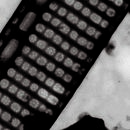Biology
provided by Diatom LifeDesk
Pseudo-nitzschia calliantha is a domoic-acid-producing, pennate diatom. However, not all strains of this species are toxin-producers. Compared to other Pseudo-nitzschia species it does not produce high levels of domoic acid. It is often found in coastal regions and can form monospecific blooms.
- license
- cc-by-nc
- copyright
- Thessen, Anne
Diagnostic Description
provided by Diatom LifeDesk
From Lundholm et al. 2003: Overlapping cells in colonies. Cells linear in valve view; tapering part of the valve toward the tips very short, in girdle view linear. Transapical axis of valves 1.3-1.8 microns, apical axis 41-98 microns. Eccentric raphe divided in the middle by a central nodule. The fibulae regularly spaced, 15-22 in 10 microns, interstriae 34-39 in 10 microns. Striae with one row of round to square poroids, 4-6 poroids in 1 micron. Hymen of poroids perforated by 7-10 sectors. Valve mantle structured as valve face, one poroid high. Cingulum with three open bands, all containing 42-48 striae in 10 microns. Each stria 2-3 poroids wide and a varying number of poroids high, the number decreasing in abvalvar direction.
- license
- cc-by-nc
- copyright
- Thessen, Anne
Distribution
provided by Diatom LifeDesk
Pseudo-nitzschia calliantha is found in tropical and temperate coastal waters. It has a more or less cosmopolitan distribution. It is often abundant in the Mediterranean Sea. For a summary of P. calliantha reports see Lundholm et al. (2003).
- license
- cc-by-nc
- copyright
- Thessen, Anne
Ecology
provided by Diatom LifeDesk
P. calliantha can form monospecific blooms in response to seasonal changes in the water column and nutrient run-off from land. They bloom often in response to seasonal run-off and thus can be correlated with nitrogen, phosphorus, temperature and salinity (Spatharis et al. 2009, Buric et al. 2008, Spatharis et al. 2007a, b).
- license
- cc-by-nc
- copyright
- Thessen, Anne
General Description
provided by Diatom LifeDesk
P. calliantha forms the step-chains characteristic of the genus. Cells are long and thin. Each stria contains one row of round to square poroids with a hymen perforated in a flower pattern. For a summary of P. calliantha morphology see Lundholm et al. (2003).
- license
- cc-by-nc
- copyright
- Thessen, Anne
Management
provided by Diatom LifeDesk
Pseudo-nitzschia calliantha has caused domoic acid contamination of shellfish in Atlantic Canada.
- license
- cc-by-nc
- copyright
- Thessen, Anne
Physiology
provided by Diatom LifeDesk
A Canadian isolate of P. calliantha had a maximum specific growth rate of 0.74 ± 0.02 and a maximum pH for growth of 9.0 in the laboratory (100 micromolar photons m-2s-1 and 15°C; Lundholm et al. 2004).
- license
- cc-by-nc
- copyright
- Thessen, Anne
Reproduction
provided by Diatom LifeDesk
Pseudo-nitzschia calliantha can reproduce asexually through cell division and sexually to restore cell size (Davidovich & Bates 1998). Reproduction in P. calliantha is heterothallic (Amato et al. 2007).
- license
- cc-by-nc
- copyright
- Thessen, Anne
Size
provided by Diatom LifeDesk
The average cell volume of a Canadian isolate was 250 ± 12 cubic microns (Lundholm et al. 2004).
- license
- cc-by-nc
- copyright
- Thessen, Anne

